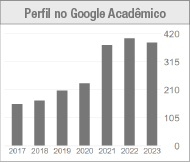A classification of groups of clowns for teaching-learning in Cuba
DOI:
https://doi.org/10.5965/1414573101462023e0103Keywords:
clowns , teaching-learning, National Clown School of CubaAbstract
The article proposes a classification of groups of clowns according to their locations. It is the result of the theoretical and methodological research sustained in different training actions at the National Clown School of Cuba, from the need to strengthen the teaching-learning of this scenic specialty in the different academies in which it is currently taught. The proposal are fundamentally based on the history of the clown with critical references in the Cuban experience.
Downloads
References
ALBERINI, Massimo. El clown. Historia apasionada de los continuadores de Arlequín. Triunfo, Salamanca, n. 42, p. 55-59, 1963. Disponible en: https://www.triunfodigital.com/mostradorn.php?anyo=XVIII&num=42&imagen=55&fecha=1963-03-23. Acceso el: 7 mar. 2022.
AMADO, Miguel Angel. La dramaturgia del clown teatral en la práctica artística de Teatro Tuyo: La estación (2009), Gris (2013) y Superbandaclown (2016). La Habana, 2021. Tesis (Licenciatura) - Universidad de las Artes, ISA.
AMADO, Miguel Angel. Un abordaje histórico en torno a la dramaturgia del clown en Cuba. Investigación teatral. Revista de artes escénicas y performatividad, Veracruz, v.13, n.22, p. 87-102, 2022. Disponible en: https://doi.org/10.25009/it.v13i22.2720. Acceso el: 31 dez. 2022.
BALIARI, Bruna y ROSADO, Teresa. Lo esencial es invisible a los ojos: payasos que humanizan y promueven salud. Aletheia. Canoas, n.31, p. 4-15, 2010. Disponible en: http://pepsic.bvsalud.org/scielo.php?script=sci_arttext&pid=S1413-03942010000100002&lng=pt&tlng=es.
BESTETTI, Verônica. O palhaço entre a renovação e a profanação. Boca Larga: Cuaderno dos Doutores da Alegria, n.1, p. 67-83, 2005.
BOURDIEU, Pierre. Sociología y Cultura. México: Editorial Grijalbo, 1990.
CORDERO, Rosa Virginia. La figura del clown y su fusión con las Artes Visuales en la representación del vacío. Ecuador, 2013. Tesis (Licenciatura) – Universidad de Cuenca.
CHAMÉ, G. Taller Técnica del clown. A. Toledo (comp.) Biblioteca Balbuceando Teatro de Córdoba, 2014.
CORTÉS, Agustín y CORTÉS, Dina Elizabeth. Bases teóricas y metodológicas de los procesos de intervención socioeducativa. Conrado. Revista pedagógica de la Universidad de Cienfuegos, v.17, n. 80, p. 356-362, 2021. Disponible en: http://scielo.sld.cu/pdf/rc/v17n80/1990-8644-rc-17-80-356.pdf. Acceso el: 10 set.2022.
FIGUEROA, Fernando. El payaso como humanizador de la cultura. Vereda. Andar la cultura, n. 2, p.19-27, 2014. Disponible en: https://www.researchgate.net/publication/271587756. Acceso el: 10 set. 2021.
GENÉ, Hernán. La dramaturgia del clown. Ciudad de México: Paso de Gato, 2015.
GENÉ, Hernán. El arte de ser payaso. Ciudad de México: Paso de Gato, 2016.
HOYOS, J. M. Clown más que una nariz roja. Teatro Polichinela, 2016. Disponible en: http://freeditorial.com/books/pdf.
LECOQ, Jacques. El cuerpo poético, una pedagogía de la creación teatral. Barcelona: Ediciones Alba, 2011.
MAESTRE, C. Arte e intervención social: las artes escénicas en los centros penitenciarios. Jáen, 2016. Tesis (Licenciatura) - Universidad de Jáen. Disponible en: https://tauja.ujaen.es/bitstream/10953.1/2949/1/TFG%20-%20Maestre%20Monblan%2c%20Carmen.pdf.
MAGELA, André Luiz Lopes. Normatividade da cooperação em aulas de teatro. Urdimento, Florianópolis, v. 1, n. 34, p. 110-128, 2019. Disponible en: https://doi.org/10.5965/1414573101342019110. Acceso el: 25 ene. 2023.
MARTÍN, Isabel Gema. La intervención socioeducativa: diseño, desarrollo y evaluación (Vol. I). Reseña de libro. Revista de Educación Social, 2020 - Universidad Nacional de Educación a Distancia. Disponible en: https://eduso.net/res/revista/30/resenas/la-intervencion-socioeducativa-diseno-desarrollo-y-evaluacion-volumen-i/.
MARTÍNEZ TABARES, Vivian. La humildad del claun. In: MUGUERCIA, Magaly (coord.). Pedagogía y experimentación en el teatro latinoamericano de la EITALC. México: Escenología A. C., 1996. p. 113-126.
MINISTERIO DEL TRABAJO Y SEGURIDAD SOCIAL. Gaceta Oficial de la República de Cuba, n. 12. La Habana, 2010.
NOGUEIRA, Wellington. Doutores da Alegria: o lado invisível da vida. São Paulo: Palas Athena, 2006.
PAVIS, Patrice. Diccionario del teatro: dramaturgia, estética y semiología. Buenos Aires: Paidós, 2008.
PERAMO, Hortensia. El campo artístico-pedagógico: una especificidad necesaria. La Habana: Editorial Universitaria, 2014.
PÉREZ-LÓPEZ, Jorge y MURILLO, Lorena. El interminable período especial de la economía cubana. Foro Internacional, Ciudad de México, v. 43, n.173, p. 566-590, 2003. Disponible en: https://forointernacional.colmex.mx/index.php/fi/article/view/1663.
REPETTO, Agustina. Definición de Grupo. Definición ABC. Disponible en: https://www.definicionabc.com/social/grupo.php. Acceso el: 30 dez. 2022.
ROMIEUX, Michel. Aproximación antropológica al arte. Revista Chilena de Antropología, n.13, p. 155-161, 1995. Disponible en: https://revistadeantropologia.uchile.cl/index.php/RCA/article/view/17524.
ROS, Francisco Javier. Cómo reivindicar derechos humanos a través del arte del clown: La función social en el payaso. Revista de Educación Social, España, n. 20, p. 198-210, 2015a. Disponible en: https://eduso.net/res/revista/20/el-tema-experiencias/como-reivindicar-derechos-humanos-a-traves-del-arte-del-clown-la-funcion-social-en-el-payasob.
ROS, Francisco Javier. La formación de profesionales del clown socioeducativo: una propuesta futura. En Pedagogía social, universidad y sociedad. Ángel de Juanas Oliva y Ana Fernández García (coord.). Universidad Autónoma de Barcelona, 2015b.
SALVATIERRA, Carmina. La escuela de Jacques Lecoq: una pedagogía para la creación dramática. Barcelona, 2006. Tesis (Doctorado) – Universidad de Barcelona. Disponible en: https://diposit.ub.edu/dspace/bitstream/2445/107489/6/CSC_TESIS.pdf.
SANZ, Teresa y HERNÁNDEZ, Fernández. Escenarios de práctica en el currículo: desarrollo e innovación educativa. La Habana: Editorial Universitaria, 2016. Disponible en: http://www.eduniv.cu/items/show/553.
VÁZQUEZ DE CASTRO, Ana. El clown, ese ser único. Revista do Lume, Campinas, n. 4, p. 9-18, 2012. Disponible en: https://orion.nics.unicamp.br/index.php/lume/issue/view/22. Acceso el: 9 abr. 2021.
VENERO DE LA PAZ, Hilda. El círculo mágico: orígenes del circo en Cuba 1492-1850. Santiago de Cuba: Editorial Oriente, 2016.
Published
How to Cite
Issue
Section
License
Copyright (c) 2023 Urdimento - Revista de Estudos em Artes Cênicas

This work is licensed under a Creative Commons Attribution 4.0 International License.
Copyright Statement
The articles published by the magazine are free to use. The copyright is all assigned to the magazine. The articles whose authors are identified represent the expression from the point of view of their authors and not the official position of the journal Urdimento. The author (s) undertakes whenever publishing material relating to the article published in Revista Urdimento mention the said publication as follows: This article was originally published by Urdimento magazine in its volume (put the volume), number (put the number) in the year of (put the year) and can be accessed at:
http://www.revistas.udesc.br/index.php/urdimento
This work is licensed under a Creative Commons Attribution 4.0 International License.




